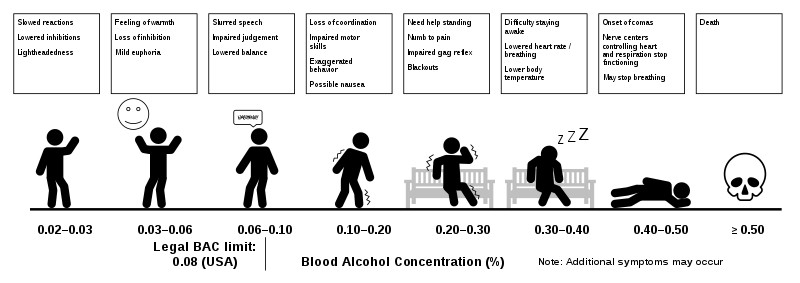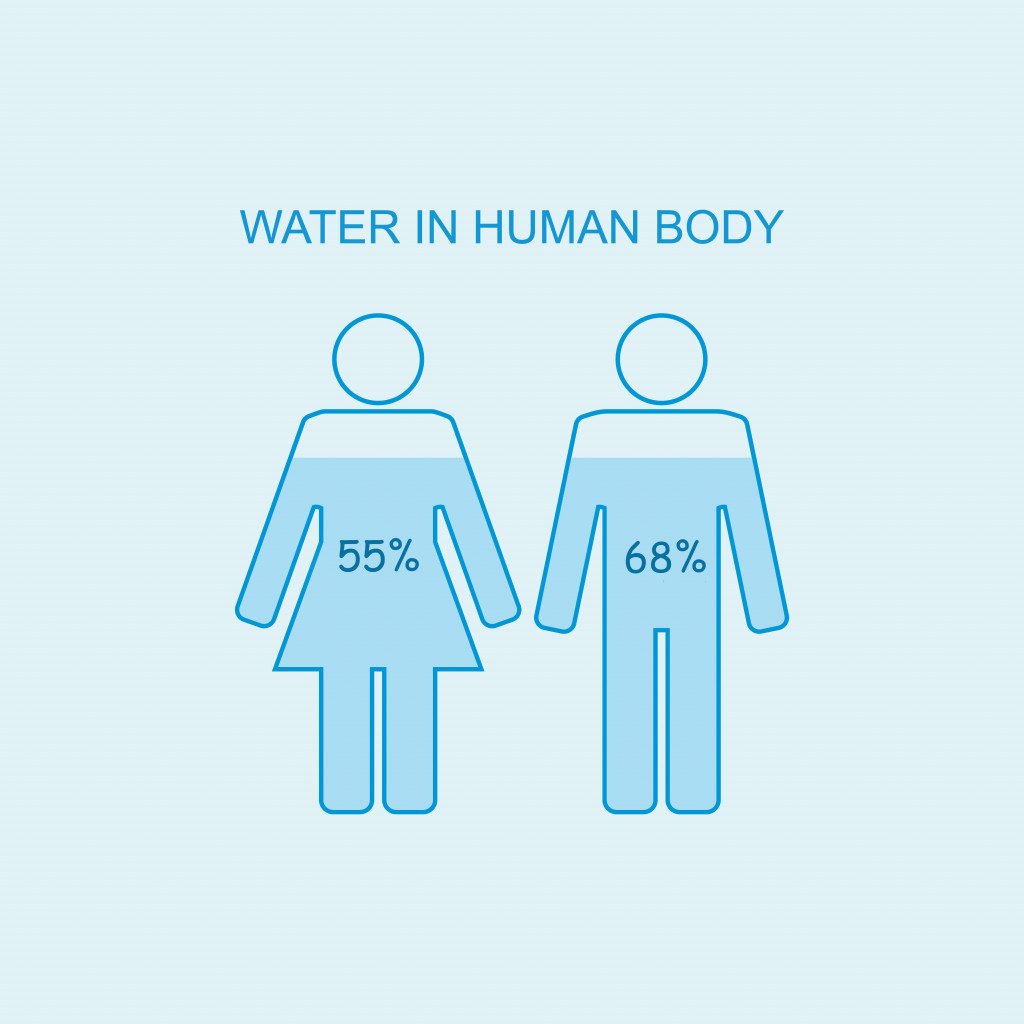Table of Contents (click to expand)
The amount of alcohol in the blood tends to be higher in females who consume the same amount of alcohol over the same period of time as men. This is due to a host of factors, from water content in the body to how fast the body breaks down the alcohol.
One evening, Sam and Sally went to a bar. They both ordered a glass of beer and began their conversation. Two hours and 4 glasses of beer later, Sally started to feel a bit tipsy, while Sam was still quite sober.
They both weigh around 68 kgs (150 pounds) and chugged the same amount of alcohol – 4 servings of 354ml (12oz) beer – in 2 hours. Yet, the effects of alcohol were visible only on Sally.

Why does a drink consumed in the same quantities affect the two sexes differently? What role does our biology play in creating this difference?
Recommended Video for you:
The Role Of Blood Alcohol Concentration
Ideally, Blood Alcohol Concentration (BAC) should be the same for individuals consuming the same amount of alcohol. However, that’s not the case. In reality, the amount of alcohol in the blood tends to be higher in females who consume the same amount of alcohol over the same period of time as men.
Sally’s BAC was approximately 0.1%, whereas Sam’s BAC was only about 0.08%. Generally, at 0.1% BAC, one starts to feel drunk and experiences a loss of judgment and coordination. Your speech might begin to slur and you may experience hearing impairment, as well as delays in reaction time.

The difference in the level of blood alcohol concentration is due to 4 major factors:
- Body Size
- Water content in the body
- Ability to metabolize alcohol
- Hormones
Body Size
The size of your body determines your ability to dilute alcohol within the body. This is because a person with a smaller body build will have less space to dilute the alcohol than a person with a larger body build.
Additionally, the ratio of muscle to fat in an individual also comes into play during the process of alcohol diffusion. The amount of water that is available for alcohol to dilute itself is higher in muscles than in fats. This is because ~76% of muscle tissue contains water, which is significantly more than fat tissues. Thus, when alcohol-carrying blood flows through the body, muscle tends to absorb more alcohol than fat.
Generally, men have a greater muscle-to-fat ratio than women, and their muscle tissue has a large amount of blood flowing through it. The large volume of blood flowing through muscle tissues helps men dilute their alcohol more efficiently than women.

On the other hand, fat allows a much smaller amount of blood to flow through it. Thus, the higher fat percentage in females causes alcohol to become more concentrated in their blood, which increases their BAC.
Therefore, despite consuming the same amount of alcohol, Sally, who has a smaller body build as compared to Sam, will have a higher BAC.
Water Content
Imagine adding 3 teaspoons of sugar to a glass with 250ml water and another glass with 500ml water. Which of the two will have a higher concentration of sugar? The one with less water, right? The same principle applies to our body when it comes to the concentration of alcohol.

Alcohol is soluble in water, so it tends to move into the water spaces of our body, like the bloodstream, along with intracellular and extracellular spaces. About 55% of a woman’s body is composed of water, while a man’s body is made up of about 68% water. The extent of alcohol dilution is therefore greater in men than in women. Due to this difference in the water content of the body, Sally’s BAC will be higher than Sam’s.
The Alcohol Dehydrogenase Enzyme (ADH)
When you drink any liquid, it first passes through your gastrointestinal (GI) tract. The stomach is the first site of alcohol metabolism, where it absorbs the alcohol passing through it into the bloodstream. The capillaries then carry the alcohol to the liver via portal veins.
The liver is the primary site of alcohol metabolism, although some alcohol is metabolized in the stomach. The liver cells produce an enzyme called alcohol dehydrogenase (ADH), which acts as a catalyst for the oxidation of ethanol. Some level of ADH is also found in the stomach and is known as gastric ADH. While the majority of alcohol metabolism occurs in the liver, gastric ADH also oxidizes a small portion of alcohol.
ADH catalyzes ethanol to form acetaldehyde, a relatively toxic compound. This is the reason behind the undesirable effects of alcohol, such as nausea and headaches. Acetaldehyde is further oxidized by another enzyme called acetaldehyde dehydrogenase (ALDH) to form acetic acid, which is inactive. The cells in our body eventually turn acetic acid into carbon dioxide and water.
Although the mechanism of alcohol metabolism remains the same for both sexes, what creates a big difference in how we respond to alcohol is the amount of ADH present. Males have active forms of ADH in both their stomach and liver, which metabolizes alcohol rapidly, whereas females have a less active form of ADH in their liver and almost no ADH in their stomachs.
Due to the presence of that extra ADH in the male stomach, they can reduce the absorption of alcohol into the bloodstream by 30%. Since the ADH present in the female liver is not as efficient as in males, they tend to absorb more alcohol in their bloodstream. This results in increased BACs for women, as compared to men.
Hormones
Along with having a lousy amount of ADH, it turns out that female hormones aren’t helpful either. The fluctuation in hormone levels during the pre-menstruation phase causes women to experience slower alcohol metabolism and higher BAC. They also experience a longer period of intoxication than menstruating and post-menstruating females. The same effect can be observed in women taking oral contraceptives.
Conclusion
Even though biology has tipped the scale in men’s favor when it comes to how alcohol affects our bodies, that doesn’t necessarily mean that women can’t enjoy alcohol. There is a way around this problem. Women simply need to adjust their alcohol intake according to their body weight. This means, if Sally drinks 3 servings of 12oz beer in one hour, she can attain the same level of intoxication as Sam, i.e., around 0.08%.

The inefficient metabolism of alcohol in women also means a greater chances of experiencing impairment after drinking. Women who drink were found to be more prone to short- and long-term consequences of alcohol consumption, as compared to men. They are at a higher risk of developing diseases related to the liver and heart, neurotoxicity, and memory blackouts caused by drinking.
References (click to expand)
- Are Women More Vulnerable to Alcohol's Effects?. The National Institute on Alcohol Abuse and Alcoholism
- Blood Alcohol Concentration(BAC) - UT Health Services. The University of Texas at Austin
- Gender and Blood-Alcohol Content | University of Puget Sound. The University of Puget Sound
- Why Biology Matters When It Comes to Drinking Alcohol.. Cornell University
- Alcohol 101-Gender Differences. The University of California, Santa Barbara
- Gender Differences in Alcohol Metabolism - Sites@Duke. Duke University












